

Suunto Blog
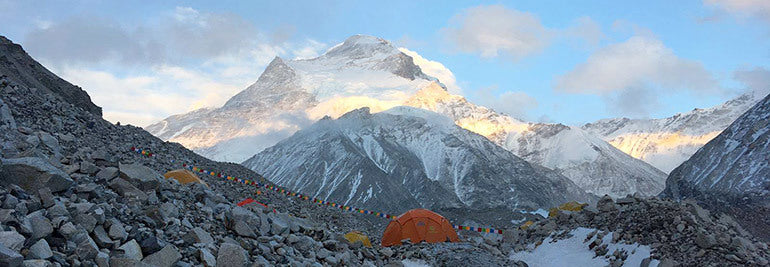
It’s not easy being Emelie! Get in the mind of one half of a mountain-sport power couple
I’ve been to the Himalayas before, but not like this
I’ve been running in the Himalayas plenty, but I’ve never done anything quite this: an attempt on Cho Oyu, an 8000m peak and the sixth tallest mountains in the world.
We did all the acclimatization at home
I was there for less than two weeks – most people take two months to acclimatize. This is very much new-school, fast-and-light alpinism. We did all the acclimatization at home hooked up to a machine that simulated being up at 7500m.
People hear we did an expedition, and they think ‘sherpas’
But that’s not how we did it. That’s not how I want to go the mountains, and not how Kilian wants to go to the mountains.
There was no pressure
This was a trip I did for myself, out of my own pocket – so there was very little pressure to ‘do it for the sponsors’. I wanted to explore for myself and see what was possible for myself.
At sea level Kilian is much faster
But at altitude we start to even out a little bit more – although he will always be stronger and more technical. We were surprised at how fast we were moving at altitude – about 250m an hour at 7500m. That’s pretty fast.
I reach 7500m and 7800m on two different days
The first time was a planned acclimatization. The second attempt was a summit bid – it was our last day, and there was a small weather window. But it got late, bad weather started rolling in, and I simply decided to turn around. Kilian and I discussed that he would go on. I had to wait a few hours for him to come down – during that time I regretted a bit the decision to split up.
Ueli’s death gave us a big scare
We were in Cho Oyu we got the news about Ueli Steck. I didn’t know him personally well, but he was friends with Kilian. He was extreme but he was a hero. His life was an affirmation of everything that is possible. When he died it was hard.
Kilian never considered not following through
There is a big difference between Ueli’s very technical route and Kilian’s Everest Route. I knew Kilian was in a really good shape and responding well to the altitude. I knew he would be fine on Everest in the right conditions. When he was taking longer than expected I began to worry a bit, as Kilian is usually extremely good at predicting his times – but I was getting updates from Seb Montaz.
I don’t want to do Everest
I want to go to some high altitude mountains. I really liked it. Mountains are the foundation, racing is just the topping. I love running and skiing, and I’m fascinated with alpinism, but I’m more concerned about the exposure. I don’t like that. I’m a big fan of life. I don’t see myself moving in the kind of terrain that Ueli did, in the way that he did. Even if I attained the technical skills, I don’t think I want to be here.
I would like to go back to Mt Blanc
Ii have been running up and down many times, but I want to put a record on that one – there’s not so many women doing it. I would like to go back to Cho Oyu to ski, as the winter route looks amazing. Some other bigger peaks as well. But Cho Oyu on skis might be my next dream trip.
I am happy Kilian is done
I want to keep his passport so that he can’t go anywhere for some time!
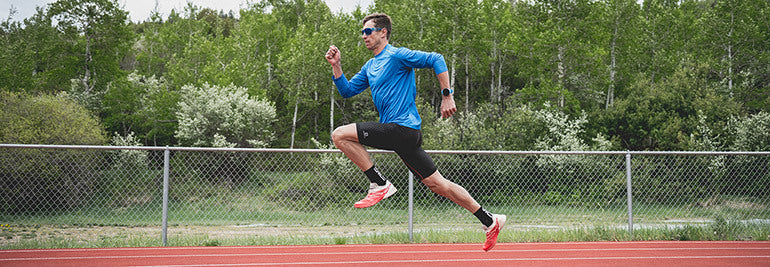
#howdoirun makes runners stronger
“I was surprised by how well people ran in general, I expected much worse,” says running coach Adam St. Pierre from CTS. Adam and Jason Koop, another CTS coach, have been commenting the running videos.
What were the most common issues you saw in the videos?
“I think the most common issues I saw related to posture. A few people leaned too far forward, bending at the waist, a few people were too straight up (or even leaning back). Proper running mechanics starts with posture. Without good posture it is very difficult to have an effective arm carriage or sufficient hip flexion and extension. If hip flexion is limited, it is very difficult for a runner not to overstride. If hip extension is limited, it puts strain on the lower back and limits the ability of the gluts to produce power,” Adam St. Pierre explains.
Any tips on how to move forward?
“Stand tall and run happy, that fixes most issues,” concludes coach Jason Koop.
LEARN 8 ESSENTIAL RUNNING FORM DRILLS
And the winners are…
Three of the most inspiring #howdoirun videos won Suunto Spartan Sport Wrist HR watches. Here are the winners.
Tim Larsson from Åre, Sweden
One last run before China. So, @suunto, how is my form? #suuntorun #howdoirun #xtrailadventurerace #xtrail #älskaåre
A post shared by Tim Larsson (@tmlarsson) on May 30, 2017 at 2:22am PDT
Tim Larsson comes from Åre, the mountain capital of Sweden. Coach Adam gave Tim mostly positive feedback, but pointed out an issue Tim was already aware of. “Due to weak hips I have a slight inward rotation on my left foot. This is something I have been working on and it feels good to get a confirmation,” says Tim.
“I have a small dream of running the entire Kungsleden (“The King’s Trail”), a 450-kilometer multiday trail run, here in Sweden in the end of the summer. So my focus now is simply on injury prevention so that I can go on for long periods. I am also trying to become a better, more efficient climber for the skimo season next winter.”
Aaron Harwood from Sydney, Australia
Filmed for the Suunto "How do I run" Contest on Sunday 11 June 2017. This was filmed by my awesome eight year old son. The time at the end is my finish time from the Sydney Morning Herald Half Marathon last month. I need some tips to run faster 😃. What a great morning. Thanks Suunto. #howdoirun #suunto #running #triathlon
A post shared by Aaron Harwood 🏊🏻🚴🏻🏃🏻 (@aaronbharwood) on Jun 10, 2017 at 10:04pm PDT
“Adam’s feedback has been really helpful. I was aware that I heel strike causing a deceleration at each stride. I was unaware of my posture and how that was making me overstride,” says Aaron Harwood from Sydney, Australia.
“As I run now I’m constantly thinking about maintaining an upright posture. I’ve noticed in the last few days that I’m now working other muscles as I can feel a difference during recovery. By reducing the tendency to overstride, I’m also able to maintain a quicker cadence. I will be adding high knee drills into my routine and I’m sure I’ll be able to start seeing my speed increase.”
To keep his motivation high, Aaron already has a goal in his mind “I’d like to run the New York marathon next year.”
Sarah Brough from Seattle, WA, USA
Posting this for the @suunto #howdoirun event ... I never really was an avid runner. Up until a year and a half ago, I couldn't even make it 1.5 miles. But, after having my second kid, I felt like I needed to improve my personal health and so, I started to run. Now, running has become an outlet for me, a way to challenge myself and see what my body can accomplish. There have been a lot of ups & downs, but through a lot of training, I've been able to accomplish goals that I never imagined I could, like running a full marathon & 2 half marathons. I've come to love the mental game, the runner's high and the sense of accomplishment I feel once I've beaten a PR. I want to keep improving which is why @suunto I'd love to know #howdoirun 🏃🏼 #suuntorun #suunto
A post shared by Sarah Brough (@sarbrough) on Jun 8, 2017 at 9:48pm PDT
“I've been able to work on coach Adam St. Pierre’s suggestions on a few runs already and honestly, it's been tough to change my stride. But, it feels a lot better when I do it. Also, I was able to go faster when I really focused on it, which is great because that's what I am most focused on right now in my training,” says Sarah Brough from Seattle, WA, USA
Sarah has set herself a goal to run two half marathons, with one of them being under two hours. “I just finished my first half in May & got a time of 2:05. My second one is in the end of August & I'm hoping to shave off those last 5 minutes, so I can reach my goal.”
Congratulations, Sarah, Tim and Aaron. And thank you everyone for submitting your videos Happy running!
Main image by Matt Trappe
READ AN INTRO TO DISTANCE RUNNING TECHNIQUE
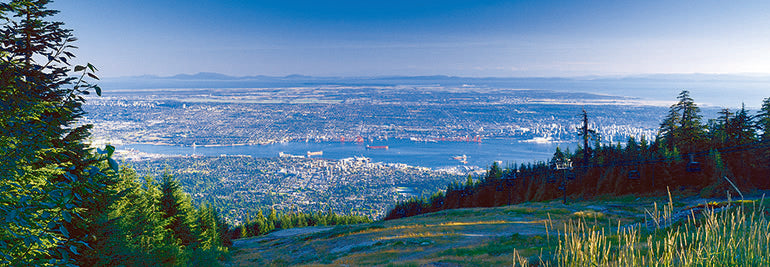
Simon Donato takes on The Grouse Grind
The Grouse Grind is an iconic trail up the face of Grouse Mountain, overlooking Vancouver, British Columbia, Canada. The trail is 2.9 kilometers long, with an elevation gain of 853 meters. Locals often refer to the trail as “Mother Nature’s Stairmaster.”
On Tuesday, June 20th Suunto Canada will be sponsoring the Suunto Multi-Grind Challenge. From dawn till dusk, racers will challenge each other to achieve the most Grouse Grind ascents in a one-day period. The current Multi-Grind Challenge record is 16 ascents! Or, over 13,500 meters of climbing!
What appealed to you about this race?
I’m attracted to this race because it’s got all the elements that I enjoy: Long day, vertical terrain, legendary route, and I know that I’ll get to face some mental battles along the way. The Grouse Grind is such an iconic route that one lap just doesn’t do it justice.
Any tips for tackling the Grouse Grind? There’s a lot of steps…
haha - Indeed. As with most really huge endurance challenges, this race will be won in the mind - not the legs. My goal is to keep the steps smooth and natural, not to push the pace too hard in the early stages, and try to keep it comfortable for as long as possible.
Have you ever done anything like this before?
I’ve never done a “stair climb” or “vertical” challenge per se, but I’ve put in many long days in the Canadian Rocky Mountains, both hiking and running for fun or chasing FKTs.
Any special strategies for tackling this much ascent in such a short time frame?
This race is unique because you get to rest on the descent by taking the Grouse Mountain Skyride, so trying to time things in such a way that you are not waiting for a tram car is critical. Eating, gear changes, etc., will all have to be done on the tram ride between ascents. One of the main goals is to climb at a very steady tempo - so that my splits are extremely similar lap - lap and avoid wasted time.
What will be your nutritional plan for the race?
My plan will be to take in as many calories as my body can handle - especially late in the race as that’s when I typically fade due to fatigue and a reduced desire to eat. Fatigue makes eating harder, and not eating enhances fatigue -it’s something I’ve struggled with in the past. In terms of calories - I’m going for as much real food as possible - and of course lots of Stoked Oats.
What performance metrics will you be focusing on during the race?
My biggest goal will be to maintain even splits…even if it feels painfully slow in the early stages. There is no benefit to reaching the summit after a hard push only to wait for the tram to arrive and take you back down.
Most importantly, the current record is 16 Grinds, how many do you think you can do?
Ha ha, the million dollar question. I would be happy with 14, and thrilled with 15.
What keeps you motivated during the climbs? How do you stay focused on the trail?
Motivation has always been about doing my best. It’s a question that I ask myself regularly during tough events and helps me push through the most difficult spots. In this case, I won’t be motivated by an absolute number, but more in maintaining a specific pace, and sticking to a well-designed nutrition plan.
How does your Suunto help you succeed in events like these?
I’ve always loved Suunto products - ever since I got into adventure racing in 1998. I think the bottom line is that I trust Suunto products - from watches to compasses and in a race where pacing is critical to success, having a watch (Suunto Spartan) that I trust gives me peace of mind. I know the watch will go as long as I do on the day and give me the metrics that I need to do my best - simple as that.
Any advice to newcomers of the Grind?
The Grind is an epic climb for many reasons, and tackling the Multi-Grind Challenge will move that needle well into the redzone. The most important elements to success in my opinion are setting goals (pacing, duration, etc.), managing nutrition, and adhering to a well thought out race plan. Really difficult events will challenge even the most hardened competitors and if there is no plan, or commitment to achieve a goal, then it’s always easier to throw in the towel when the going gets tough. Little things like appreciating the experience when you’re riding a high, to understanding that the lows don’t last forever will help pull athletes through this test!
Image of Simon Donato © Luis Moreira/Adventure ScienceGrouse Mountain images © Grouse Mountain
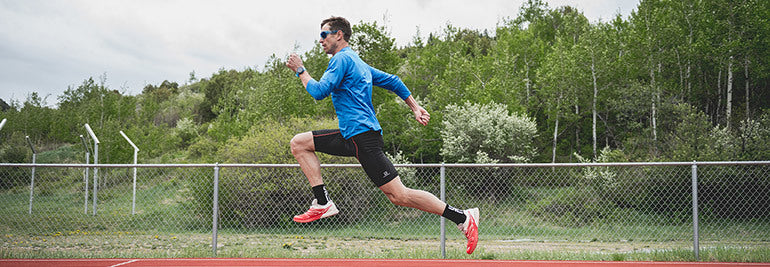
8 Essential running form drills
Improve your running technique with these essential running form drills – and follow them as a SuuntoPlus Guide on your watch!
UPDATED ON MARCH 29, 2022
In the previous weeks we have talked about running economy and given some key areas to focus on in your running technique . But how to actually change something or to improve? Here are XTERRA World Champion and professional coach Josiah Middaugh’s essential running drills for distance runners – with videos!
Follow these running form drills on your Suunto!
With the help of SuuntoPlus Guides, you can now follow these running form drills on your Suunto watch. Before starting a running exercise on your watch, go down to exercise options and select ’Running Form Drills’ from the SuuntoPlus Guides menu. Start the workout and you will see step-by-step guidance on one of your watch screens. Swipe left until you see it. Press lap (lower right button) to advance from one step to the next one.
Read on to learn the drills!
Skip with high knees (“A” skips)
Drive your knee up forcefully lifting you off the ground. Keep movements primarily in the sagittal plane. Keep your foot dorsiflexed, which means your toes drawn up towards your shin. This is a small skip since you land on the same foot and then switch. (Scroll down for a video of all the drills.)
Run with high knees
Similar to the “A” skips, but instead of skipping there is a quick transition from one foot to the other, just like running. Focus on breaking the vertical plane with your thigh each time.
“B” skips
This is just like the “A” skip, except after you drive the knee up, then extend the knee. Knee extension happens passively as you snap the leg back down with your glutes and hamstrings, pawing your foot to the ground.
Butt kicks (heel to butt)
Traditional butt kicks are usually performed incorrectly, swinging the heel in a half circle towards the butt. Instead, draw the keep up in a straight line towards the bottom of the butt or top of the hamstrings. To do this, allow the knee to come forward, but not quite as high as the high knees drill.
Power skips
This has all of the same points as the “A” skips except you are going for more height. Momentum is created by driving the knee up and also forcefully pushing off the ground.
Carioca drill
Most running is performed in the sagittal plane, but stabilizing also occurs in the frontal plane. The carioca drill is a side ways motion requiring adduction/abduction and coordination. Face sideways and cross your trailing leg in front and then behind and you continue in the sideways direction. Continue facing the same direction for your return trip.
Bounding
Bounding is a higher intensity running drill designed to improve power and efficiency. Essentially bounding is just an exaggerated run with lots of vertical and horizontal displacement. Go for both height and distance with each stride. To keep from skipping, try jogging 5-10 yards before starting the drill. These can be performed on flat ground or uphill.
Strides
Strides are just controlled sprints. Gradually increase speed for 30-40 meters and then maintain high speed with good, controlled form for another 40-60 meters. The key is not to strain or sprint all out. Make it look easy. I like 70-100 meters for these on a relatively soft surface such as a rubberized track or turf.
Watch all the running form drills on video!
Watch coach Josiah's essential running form drills here.
Josiah Middaugh is a XTERRA Pan America Champion and 2015 XTERRA World Champion. He has a master’s degree in kinesiology and has been a certified personal trainer for over 15 years (NSCA-CSCS).
Images and video by Matt Trappe
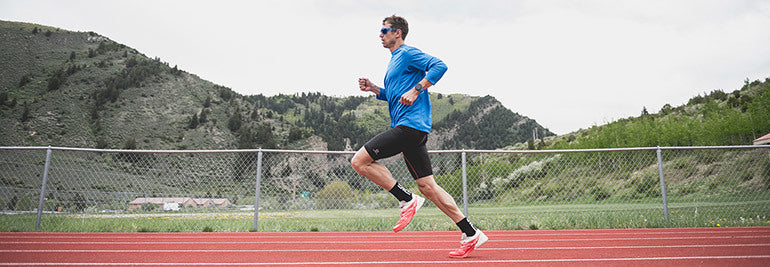
Intro to distance running technique
Stride rate
Despite the running speed, stride rate should stay within a narrow range. At race pace, cadence should be at or above 180 steps per minute, or 90 revolutions per minute (counting one leg). Suunto uses revolutions per minute, so a good goal at race pace is 90-92 revolutions per minute. During training, endurance pace for example is considerably slower, however cadence should still be close to that 90 rpm mark. I shoot for 86-90 rpms no matter how slow I am running. This means a shorter, quicker stride for endurance and recovery paces.
Foot strike
As your foot swings through and the leg extends out in front, most people set the foot down too early, creating a breaking force, heel strike, and high impact. Instead, paw back and contact the ground under your center of gravity with a softer landing propelling you in the direction of travel.
Vertical oscillation
A long, loping stride has a larger vertical component, which results in more distance traveled up and down. Think of your legs as wheels rather than pogo sticks. One way to see this is to have someone video you running along a fence and see the vertical displacement.
Running tall
This is a good mantra for any runner to keep in mind. This means maintaining a strong core, posture, and head position. Look forward towards the horizon. Imagine you are a marionette doll with a string holding you up from the top/back of your head. Uphill, think about staying vertical. For gradual downhills, lean forward so you are perpendicular to the slope.
Slight forward lean
Running tall, but with a slight forward lean. Running is a series of falls, so you want a slight forward lean which is more pronounced at fast running speeds. Do not achieve this from bending forward at the waist. You should have a straight line from your ground contact point, up through the top of your head. One drill I like is a sprinting drill called “falling starts.” Start by standing tall and then fall forward with the fulcrum point at the balls of your feet, staying long with no breaking at the waist. You will want to step forward to catch yourself, but instead of a step, immediately break out into a fast run.
Arm carriage
Your arms are your counter weights so movement is good, but it should happen naturally and without expending extra energy. Straight on, hands can swing towards the center line, but should not cross. Elbow should be bent with a slightly acute angle, less than 90 degrees to keep the lever arm short. Be careful not to carry your arms too high or elbows to wide, which results in excess strain on your shoulders, upper traps, and neck. Keep hands relaxes as if you are carrying a fragile egg in each hand.
Josiah Middaugh is the reigning XTERRA Pan America Champion and 2015 XTERRA World Champion. He has a master’s degree in kinesiology and has been a certified personal trainer for 15 years (NSCA-CSCS).
Images by Matt Trappe
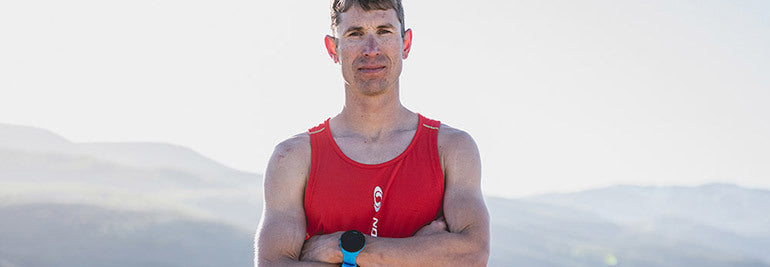
5 proven ways to improve running economy
“Running economy is the holy grail for distance runners, not a high VO 2 max,” writes Josiah Middaugh , XTERRA World Champion and a professional coach. Read on to learn more.
Running economy is the holy grail for distance runners. It was once thought that a high VO2 max was the discriminating factor for distance running performance. However, among a homogenous group of runners, VO2 max is not correlated with performance. It turns out that running economy plays a more crucial role.
For many years the Kenyans and East Africans dominated middle distance events and it was thought their aerobic capacity due to altitude training and genetics were superior, but that is not the case. Their VO2 max values were no better than world class athletes from all over the world and athletes from other endurance disciplines. Remarkably, some East Africans were able to run exceptional times with moderate aerobic capacities. The most economical distance runner ever measured could run 1500m in 3:35 with a VO2 max of only 63 ml/kg/min (Foster and Lucia, 2008).
Increase stride rate
Running mechanics can be very complex. Compared to novice runners, elite runners tend to have a shorter ground contact time, less braking forces, less vertical oscillation, less energy expended in the frontal plane, specific joint angles during phases of the run gait, and less oxygen consumed for any given pace. To think of several these things at once will probably not be helpful. Increasing stride rate can be a simple solution to a complex problem.
My former professor and world renowned running coach Dr. Jack Daniels observed that Olympic distance runners had very similar stride rates in all of the long-distance events. The stride rate he observed was over 180 steps per minute. Most novice runners tend to be closer to 160 steps per minute which causes longer ground contact time, increased braking forces, and more vertical oscillation. Visually, efficient runners experience ground contact occurring under your center of gravity (instead of out in front), less heel striking, and a smoother, less loping stride. Simply increasing stride rate without increasing pace will solve several biomechanical issues at once. As pace increases, stride length increases while stride rate remains mostly unchanged.
To master, I like to practice the quick turnover at easy to moderate speeds where it might not feel as natural. Even speeds as low as a 12 min/mi pace, it is possible to maintain a stride rate of 180 steps per minute. Think about your legs acting as wheels while your roll over the ground like road runner, rather than like pogo sticks slamming into the ground. Initially a quicker turnover might be less economical as you retrain your neuromuscular system. However, the upside will be worth it with improved running economy and less impact.
Increase mileage
Running economy has been found to fluctuate in distance runners from season to season depending on total running mileage and from year to year. In a group of elite runners, during the road racing season when mileage was higher, running economy was better compared to spring track season when mileage was lower (Kubo et al., 2010). Another study found a cumulative effect on running economy based on total running mileage in a career having a stronger effect than current running mileage (Midgley et al., 2007).
Single sport distance runners and coaches have long known the benefits from higher mileage, but simply increasing mileage linearly can lead to a slippery slope of injury, burnout, and overtraining. Although open for interpretation, these studies show the importance of consistency over time. For multi-sport athletes they imply that there may be some benefit to an off-season run focus, increasing run frequency if running is a limiter, and consistent long runs throughout the year. When increasing mileage, a conservative approach to avoid injury is to limit total mileage increases to ten percent per week, but with undulation and not linear progression.
Strength training
Strength training has the potential to improve running economy and prevent injury in a few different ways. Although running doesn't require an extremely high level of core strength, many distance runners are deficient. I like the definition of core strength as lumbo-pelvic-hip stability. With running, you are either in the air or in a single leg stance. The single leg stance requires proper timing and recruitment of this core musculature to prevent too much wasted energy. Approximately 20% of expended energy while running is spent stabilizing in the frontal plane (side to side).
Another way strength training can improve running economy is neuromuscular and structural. Replacing a portion of running volume with a small amount of heavy strength training has been shown to improve musculo-tendon stiffness, and neuromuscular efficiency. They key here is to make sure that strength training remains supplemental and replaces some of your total training volume so you aren't just increasing fatigue.
"Functional body mass uses energy but is also used to propel you forward," says Josiah Middaugh.
Lose non-functional weight
This is pretty simple and straightforward and doesn't apply to everyone. Unlike swimming, or cycling on flat ground, running economy is always dependent on total body weight. I like to think of running as a series of falls and with every stride you must lift, catch, and support your body weight. Carrying less mass will use less energy. The key here is to focus on mass that is not functional such as body fat. Small increases in lean body mass (muscle) do not affect relative running economy. Functional body mass uses energy but is also used to propel you forward, so carry what you need but not anything extra.
Perform plyometrics
Plyometric training can be a shortcut to improved running economy. Like strength training, it is important to replace a portion of training volume with plyometric training and not add it on top of your training load. Plyometrics are generally considered high intensity although most people can perform lighter versions of plyometrics called form drills. Some examples include high knees, power skipping, bounding, double and single leg hops. The mechanism has most to do with the stiffness or responsiveness of the muscle-tendon complex (Spurs, et al., 2002). A small amount can go a long way with plyometrics, so perform high intensity plyos when fresh and limit total jumps to about 200 per session. Performed 2-3 sessions per week, running economy can be improved in as little as six weeks of plyometric training (Saunders et al., 2006).
Josiah Middaugh is the reigning XTERRA Pan America Champion and 2015 XTERRA World Champion. He has a master’s degree in kinesiology and has been a certified personal trainer for 15 years (NSCA-CSCS).
Images by Matt Trappe
References
Foster, C., & Lucia, A. (2007). Running economy: the forgotten factor in elite performance. Sports Medicine, 37, 4-5, 316-319.
Kubo, K., Tabata, T., Ikebukuro, T., Igarashi, K., & Tsunoda, N. (2010). A longitudinal assessment of running economy and tendon properties in long distance runners. Journal of Strength and Conditioning Research, [E-pub ahead of print]
Midgley, A., McNaughton, L., Jones, A. (2007). Training to enhance the physiological determinants of long-distance running performance: can valid recommendations be given to runners and coaches based on current scientific knowledge? Sports Medicine, 37(10), 857-880.
Yoshida, T., Udo, M., Chida, M., Ichioka, M., Makiguchi, K., & yamaguchi, T., (1990). Specificity of physiological adaptation to endurance training in distance runners and competitive walkers. European Journal of Applied Physiology, 61, 197-201.
Saunders, P., Telford, R., Pyne, D., Peltola, E., Cunningham, R., Gore, C., and Hawley, J. (2006). Short-term plyometric training improves running economy in highly trained middle and long distance runners. Journal of Strength and Conditioning Research, 20, 4, 947-954.
Spurrs, R., Murphy, A., & Watsford, M. (2002). The effect of plyometric training on distance running performance. European Journal of Applied Physiology, 89, 1, 1-7.














































































